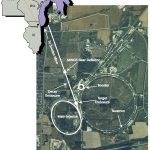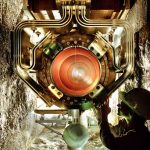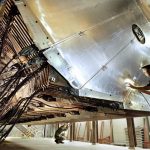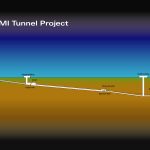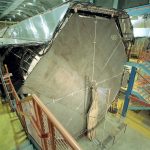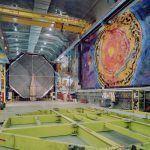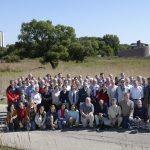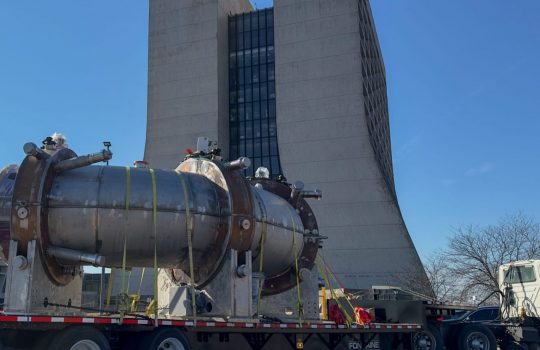BATAVIA, Illinois – Officials at the Department of Energy’s Fermi National Accelerator Laboratory today (March 4, 2005) dedicated the MINOS experiment and the beam that will send subatomic particles called neutrinos from Fermilab, near Chicago, to a particle detector in Minnesota. The Honorable J. Dennis Hastert Jr., Speaker of the U.S. House of Representatives, and Dr. Raymond L. Orbach, Director of the DOE Office of Science, officially inaugurated the Main Injector Neutrino Oscillation Search (MINOS) experiment. The Speaker unveiled the beam to send the first pulses of neutrinos on a path through the earth from Fermilab to a detector located 450 miles away, a half-mile underground in the historic Soudan iron mine in northeastern of Minnesota.
“With the MINOS experiment, Fermilab again demonstrates its position as the world’s premier facility to conduct particle physics research,” Rep. Hastert said. “With the new knowledge it generates on neutrinos, Fermilab will expand the frontiers of understanding about our universe and the way it works, and build on a reputation established over 30 years of outstanding science and discovery.”
The Neutrinos at the Main Injector (NuMI) project, with the MINOS experiment, includes over 200 scientists, engineers, technical specialists and students from 32 institutions in 6 countries, including Brazil, France, Greece, Russia, the United Kingdom and the United States. The institutions include universities and national laboratories. The U.S. Department of Energy provides the major share of the funding, with additional funding from the U.S. National Science Foundation and from the United Kingdom’s Particle Physics and Astronomy Research Council.
“Fermilab’s MINOS experiment is the newest and most powerful tool in investigating the properties of the neutrino,” said Secretary of Energy Samuel W. Bodman. “This research may lead to new insights into the early history and evolution of the universe. We eagerly look forward to the new knowledge generated by the MINOS experiment.”
The MINOS experiment will use a neutrino beam produced at Fermilab’s Main Injector accelerator to probe the secrets of these elusive subatomic particles: where do they come from, what are their masses and how do they change from one kind to another? In Minnesota, a 6,000-ton particle detector will search for neutrinos that may have changed from one kind to another during the 2.5-millisecond trip. Trillions of lab-created neutrinos will pass through the MINOS detector each year. But because neutrinos interact so rarely, only about 1,500 of them each year will collide with atoms inside the detector. The rest pass right through with no effect. MINOS scientists will use the change from one type of neutrino to another as the key to discovering neutrinos’ secrets.
“In time, the MINOS project will be viewed as a landmark event in the history of physics. This world-class research is a bold, visionary initiative which will have profound implications for our understanding of the structure and evolution of the universe,” said Congressman James L. Oberstar, whose Minnesota district includes the Soudan site. “The billion-year-old rock formations in the Soudan Underground mine, which is located in my congressional district, have provided some of the world’s richest iron ore. Now the mine may help unlock mysteries about the origins of the universe. I congratulate Dr. Earl Peterson, Director of the Soudan Underground Laboratory; the University of Minnesota; Fermilab, and the U.S. Department of Energy for being at the forefront of scientific research and discovery.”
Generating the neutrinos destined for Minnesota required building a beamline housed underground at Fermilab. The beamline is a 4,000-foot tunnel, whose direction, roughly north and slightly down, points from Fermilab to Soudan. The beamline tunnel holds the components which generate the neutrinos from protons accelerated by Fermilab’s Main Injector. Then comes the MINOS Hall, a 120-foot-long cavern located 350 feet below the surface of the lab campus, with access by an elevator traveling the equivalent of a 30-story building. The MINOS Hall holds the near detector, a smaller version of the MINOS detector at Soudan, which is used to measure the properties of the neutrinos at the start of their trip to northern Minnesota.
“Physicists from around the world are trying to understand what these mysterious neutrinos are telling us,” said Fermilab director Michael Witherell. “Today, we are embarking on a journey of exploration using the most powerful neutrino facility in the world. I am extremely proud of what the people of Fermilab have accomplished in completing the NuMI project. I would like to thank the American people and the federal government for making the necessary commitment to support great science.”
Prof. Ian Halliday, CEO of the UK’s Particle Physics and Astronomy Research Council, anticipates the revelations from the experiment’s precision measurements.
“The mysteries of the elusive neutrino are about to be unveiled,” Halliday said. “For the very first time we will be able to investigate the changing state of this bizarre particle to an unprecedented accuracy of a few percent in a controlled beam of neutrinos created in the laboratory. I’m extremely proud that UK scientists have played a key role in bringing this experiment to fruition and, in collaboration with their international colleagues, will be amongst the first in the world to study its unique characteristics.”
The MINOS far detector is located in the Soudan Underground Mine State Park, operated by the Minnesota Department of Natural Resources. As the first iron mine in Minnesota, the Soudan mine is a registered national historic site. Market forces brought operations to a close in 1962. Before expansion to allow for the MINOS detector and the Fermilab Cryogenic Dark Matter Search experiment, the Soudan underground laboratory was home to the Soudan 2 detector experiment, searching for decays of protons, the charged components of the atomic nucleus. Park staff now provide public tours underground for 30,000 to 40,000 visitors annually, viewing both the mine area and MINOS detector hall in the underground laboratory. An added attraction is a 60-foot mural, painted on the wall of the cavern by Minneapolis artist Joe Giannetti.
Michael Turner, the National Science Foundation’s Assistant Director for Mathematics and the Physical Sciences, believes the neutrinos’ infinitesimal mass belies their significant and ubiquitous impact.
“Neutrinos are always referred to as ghostly particles, as if they are of little interest and have to be apologized for,” Turner said. “Nothing could be further from the truth. Neutrinos account for as much of the mass of the universe as do stars, they play a crucial role in the production of the chemical elements in the explosions of stars, and they may well explain the origin of the neutrons, protons and electrons that are the building blocks of all the atoms in the universe. MINOS will help us better understand how neutrinos shaped the universe we live in.”
Fermi National Accelerator Laboratory, founded in 1967, is a Department of Energy National Laboratory in Batavia, Illinois, about 40 miles west of Chicago. Fermilab operates the world’s highest-energy particle accelerator, the Tevatron, on its 6,800-acre campus. About 2,500 physicists from universities and laboratories around the world do physics experiments using Fermilab’s accelerators to discover what the universe is made of and how it works. Discoveries at Fermilab have resulted in remarkable new insights into the nature of the world around us. Fermilab is operated by Universities Research Association, Inc. a consortium of 90 research universities, for the United States Department of Energy, which owns the laboratory.
For more information, please visit:
NuMI/MINOS project
http://www-numi.fnal.gov/
NuMI/MINOS Facts for Neighbors
http://www.fnal.gov/neutrinos
List of institutions collaborating on MINOS:
http://www-numi.fnal.gov/collab/institut.html
| Brazil: University of Campinas University of Sao PauloFrance: College de FranceGreece : University of Athens Russia: United Kingdom: |
United States: Argonne National Laboratory Benedictine University Brookhaven National Laboratory California Institute of Technology Fermi National Accelerator Laboratory Harvard University Illinois Institute of Technology Indiana University Livermore National Laboratory Macalester College, Minnesota University of Minnesota, Minneapolis University of Minnesota, Duluth University of Pittsburgh Soudan Underground Laboratory University of South Carolina Stanford University Texas A&M University University of Texas at Austin Tufts University Western Washington University College Of William & Mary University of Wisconsin-Madison |
Press release by MINOS collaborators in the UK
- Neutrinos, ghost-like particles that rarely interact with matter, travel 450 miles straight through the earth from Fermilab to Soudan — no tunnel needed. The Main Injector Neutrino Oscillation Search (MINOS) experiment studies the neutrino beam using two detectors. The MINOS near detector, located at Fermilab, records the composition of the neutrino beam as it leaves the Fermilab site. The MINOS far detector, located in Minnesota, half a mile underground, again analyzes the neutrino beam. This allows scientists to directly study the oscillation of muon neutrinos into electron neutrinos or tau neutrinos under laboratory conditions.
- When operating at highest intensity, the NuMI beam line transports a package of 35,000 billion protons every two seconds to a graphite target. The target converts the protons into bursts of particles with exotic names such as kaons and pions. Like a beam of light emerging from a flashlight, the particles form a wide cone when leaving the target. A set of two special lenses, called horns (photo), is the key instrument to focus the beam and send it in the right direction. The beam particles decay and produce muon neutrinos, which travel in the same direction. Photo: Peter Ginter
- The 1,000-ton MINOS near detector sits 350 feet underground at Fermilab. The detector consists of 282 octagonal-shaped detector planes, each weighing more than a pickup truck. Scientists use the near detector to verify the intensity and purity of the muon neutrino beam leaving the Fermilab site. Photo: Peter Ginter
- Fermilab completed the construction and testing of the Neutrino at the Main Injector (NuMI) beam line in early 2005. Protons from Fermilab’s Main Injector accelerator (left) travel 1,000 feet down the beam line, smash into a graphite target and create muon neutrinos. The neutrinos traverse the MINOS near detector, located at the far end of the NuMI complex, and travel straight through the earth to a former iron mine in Soudan, Minnesota, where they cross the MINOS far detector. Some of the neutrinos arrive as electron neutrinos or tau neutrinos.
- The MINOS far detector is located in a cavern half a mile underground in the Soudan Underground Laboratory, Minnesota. The 100-foot-long MINOS far detector consists of 486 massive octagonal planes, lined up like the slices of a loaf of bread. Each plane consists of a sheet of steel about 25 feet high and one inch thick, with the last one visible in the photo. The whole detector weighs 6,000 tons. Since March 2005, the far detector has recorded neutrinos from a beam produced at Fermilab. The MINOS collaboration records about 1,000 neutrinos per year.
- Far view The University of Minnesota Foundation commissioned a mural for the MINOS cavern at the Soudan Underground Laboratory, painted onto the rock wall, 59 feet wide by 25 feet high. The mural contains images of scientists such as Enrico Fermi and Wolfgang Pauli, Wilson Hall at Fermilab, George Shultz, a key figure in the history of Minnesota mining, and some surprises. A description of the mural, painted by Minneapolis artist Joe Giannetti, is available here.
- More than 140 scientists, engineers, technical specialists and students from Brazil, Greece, Poland, the United Kingdom and the United States are involved in the MINOS experiment. This photo shows some of them posing for a group photo at Fermilab, with the 16-story Wilson Hall and the spiral-shaped MINOS service building in the background.

